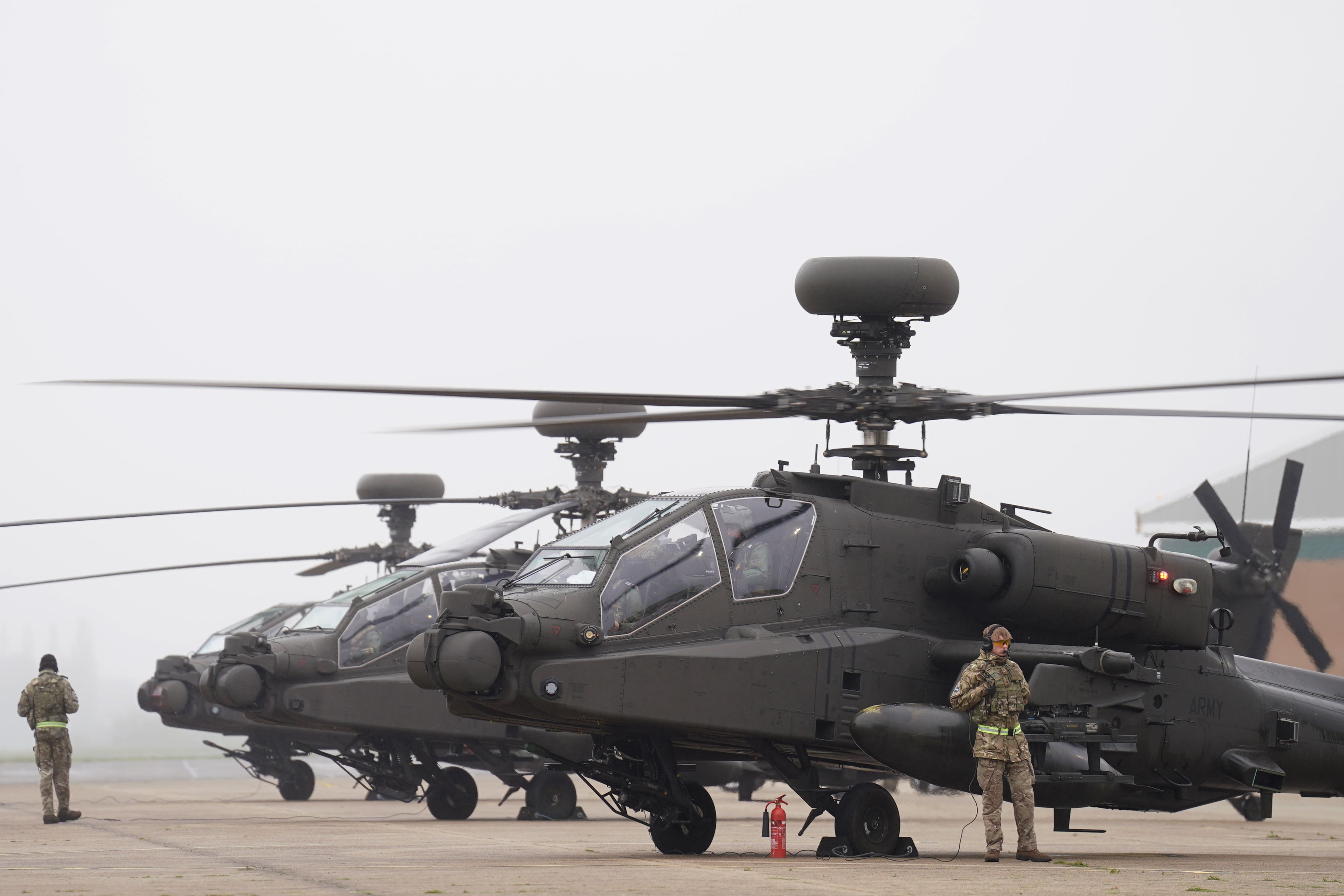British Army Apache helicopters fly to Finland for Nato training exercise
Some 20,000 British personnel are involved, among 90,000 troops from all 32 members of the alliance.

Your support helps us to tell the story
From reproductive rights to climate change to Big Tech, The Independent is on the ground when the story is developing. Whether it's investigating the financials of Elon Musk's pro-Trump PAC or producing our latest documentary, 'The A Word', which shines a light on the American women fighting for reproductive rights, we know how important it is to parse out the facts from the messaging.
At such a critical moment in US history, we need reporters on the ground. Your donation allows us to keep sending journalists to speak to both sides of the story.
The Independent is trusted by Americans across the entire political spectrum. And unlike many other quality news outlets, we choose not to lock Americans out of our reporting and analysis with paywalls. We believe quality journalism should be available to everyone, paid for by those who can afford it.
Your support makes all the difference.A fleet of nine British Army Apache attack helicopters has set out for Finland to join a training mission described as the “largest Nato exercise since the Cold War”.
The Apaches, worth £40 million each, will fly strike missions in support of large-scale Finnish army training, before heading to Estonia for an exercise where they will be joined by more British aircraft.
Four Wildcat reconnaissance helicopters and two RAF Chinook support helicopters, which took flight from Wattisham Flying Station in Suffolk together with the Apaches on Wednesday morning, will just go to Estonia and will spend a longer time there.
The training exercise with the Apache attack helicopters in Finland is called Exercise Arrow, while the one in Estonia – with all three types of helicopter – is called Exercise Swift Response.
All three helicopter types will fly and fight together in the Estonian exercise under the command of 16 Air Assault Brigade Combat Team, the British Army’s global response force.
British airborne forces are training with their Estonian, Polish and American counterparts on the latter exercise to practise seizing a foothold against armed opposition.
Air assault operations will see troops and equipment lifted by Chinooks, with the Wildcats’ surveillance equipment working with the Apaches’ advanced suite of sights and sensors to find and strike targets on the battlefield.
Around 130 vehicles – from fuel tankers to Land Rovers – are travelling by road and rail to the Baltics, with the majority of the 500 air crew, engineers and ground crew that operate the helicopters flying out.
All the activity comes under the umbrella of Exercise Steadfast Defender 24, which is testing and refining Nato’s plans for reinforcing European defences against a “near-peer adversary”.
Some 20,000 British personnel are involved, among 90,000 troops from all 32 members of the alliance.
Lieutenant Colonel Dave Lambert, 4 Regiment Army Air Corps Battlegroup Commander, said: “Exercise Steadfast Defender is the largest Nato exercise since the Cold War.”
He said it is “very easy to focus on events in Ukraine” but that “our role within Nato is to be ready for all threats”.
Lt Col Lambert said it will be the first time the new Apache AH-64E has deployed on overseas operations for the British Army, and added he was “really looking forward to seeing what it’s capable of”.
He continued: “This is one of the largest overseas helicopter deployments we have done outside of Iraq and Afghanistan – and almost certainly will be the largest thing that most of our people will have done.
“It provides a powerful contribution to support Nato training on Steadfast Defender.
“Led by the state-of-the-art Apache AH-64E, the capabilities we deliver are battle-winning and contribute fully to the combined arms battle.
“The significance of what we are doing is matched by the demanding nature of the deployment – we’re deploying helicopters and everything we need to operate them across Europe, to build relationships with our allies, understand their capabilities and procedures, to then plan and carry out missions together.”
Defence Secretary Grant Shapps said: “National security is the first duty of government, which is why we have the capabilities and international alliances in place to protect the UK from both current and future threats.
“In a more dangerous world, this deployment shows that the UK is once again demonstrating how we improve Nato’s ability to meet the challenge of modern threats.
“The cutting-edge new Apache helicopters will join 20,000 British soldiers, sailors and aviators on Exercise Steadfast Defender, sending an unmistakeable message of our commitment to the alliance.”
The helicopters had been due to set out on Tuesday, with their departure postponed by one day until Wednesday due to adverse weather.